Literature Review: Effectiveness of Change Management in the NHS
VerifiedAdded on 2020/06/06
|11
|3371
|217
Literature Review
AI Summary
This literature review chapter examines change management within the National Health Service (NHS), focusing on its importance, effectiveness, and impact on delivering quality services. It explores the evolution of technology in healthcare, emphasizing the need for change to improve patient care. The review discusses the benefits of effective change management, such as improved skills, patient satisfaction, and organizational performance, while also addressing the challenges, including employee resistance and the need for training. It also covers the impact of digital technologies and the use of models like Kottler's to implement change. The chapter highlights the role of information architecture and organizational semiotics in healthcare, emphasizing the importance of adapting to new technologies and managing information effectively to achieve success in the healthcare sector. It also emphasizes the need for strategic planning and employee awareness to ensure successful change implementation.
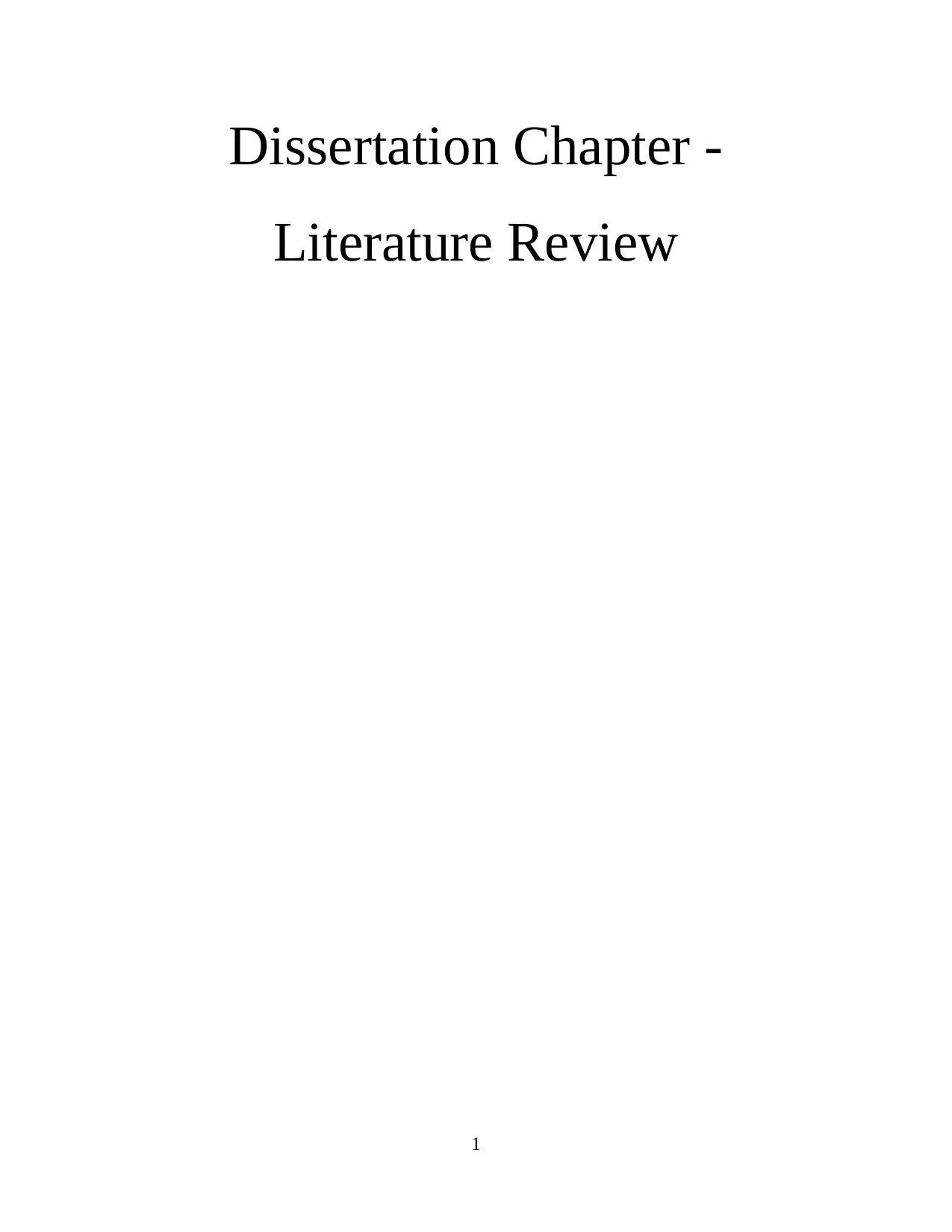
Dissertation Chapter -
Literature Review
1
Literature Review
1
Paraphrase This Document
Need a fresh take? Get an instant paraphrase of this document with our AI Paraphraser
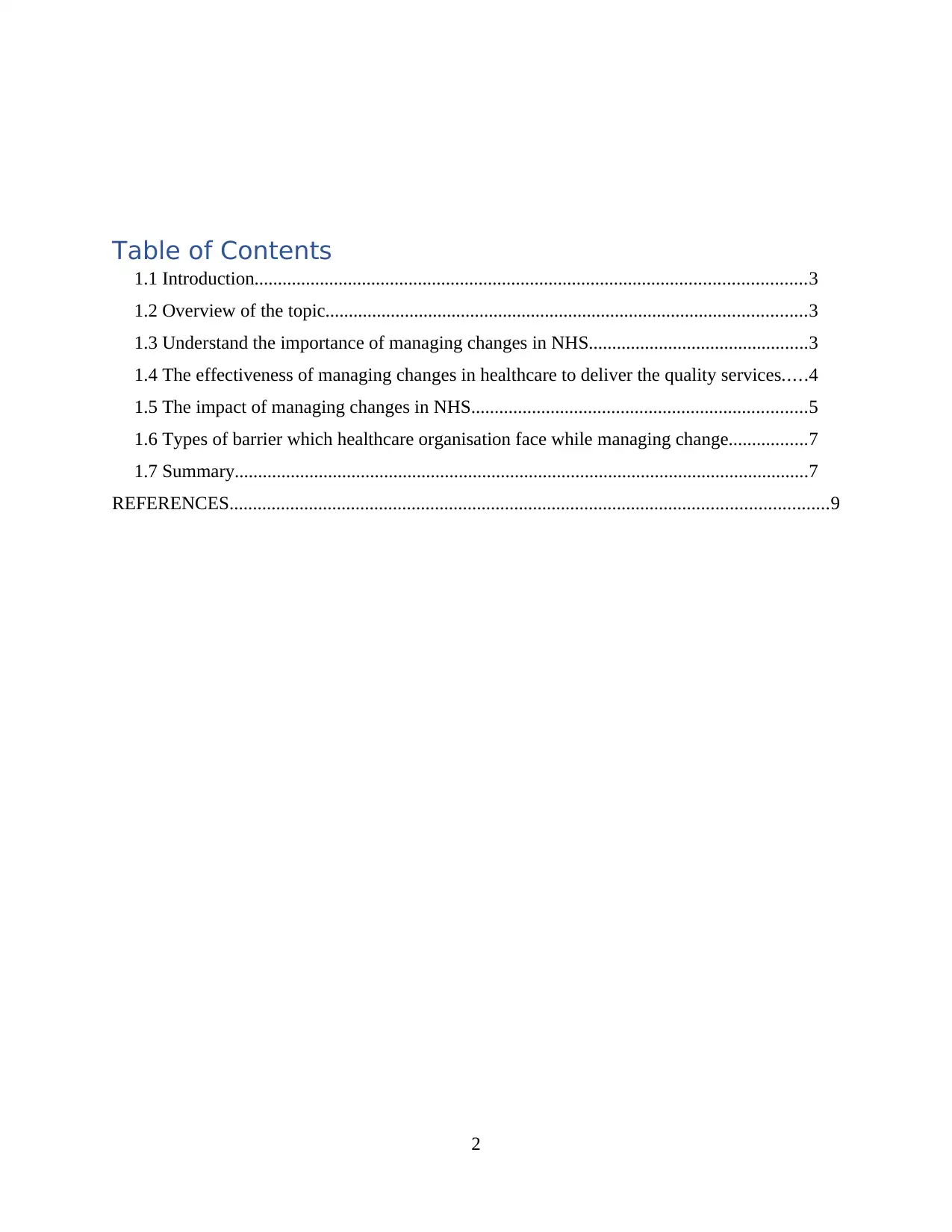
Table of Contents
1.1 Introduction......................................................................................................................3
1.2 Overview of the topic.......................................................................................................3
1.3 Understand the importance of managing changes in NHS...............................................3
1.4 The effectiveness of managing changes in healthcare to deliver the quality services.....4
1.5 The impact of managing changes in NHS........................................................................5
1.6 Types of barrier which healthcare organisation face while managing change.................7
1.7 Summary...........................................................................................................................7
REFERENCES................................................................................................................................9
2
1.1 Introduction......................................................................................................................3
1.2 Overview of the topic.......................................................................................................3
1.3 Understand the importance of managing changes in NHS...............................................3
1.4 The effectiveness of managing changes in healthcare to deliver the quality services.....4
1.5 The impact of managing changes in NHS........................................................................5
1.6 Types of barrier which healthcare organisation face while managing change.................7
1.7 Summary...........................................................................................................................7
REFERENCES................................................................................................................................9
2
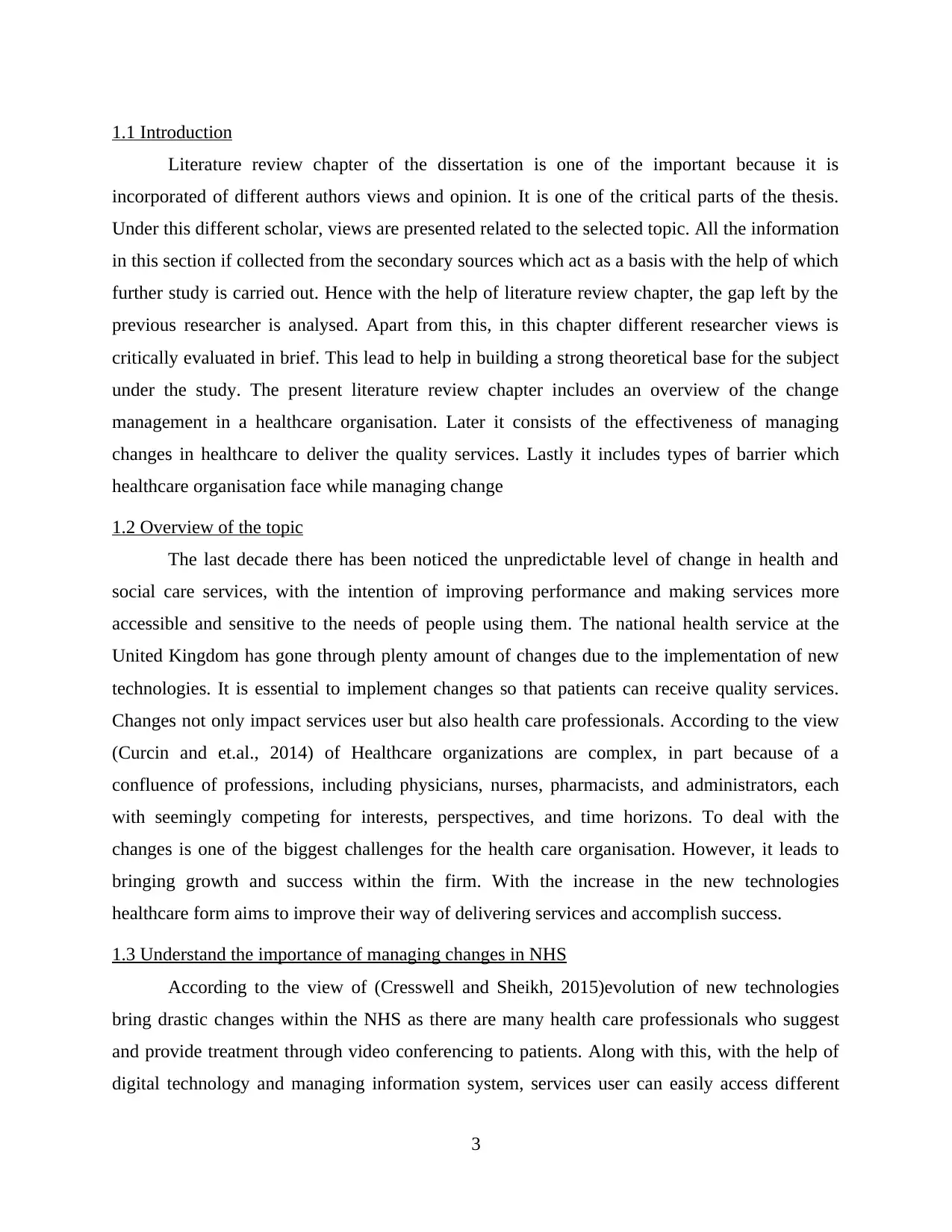
1.1 Introduction
Literature review chapter of the dissertation is one of the important because it is
incorporated of different authors views and opinion. It is one of the critical parts of the thesis.
Under this different scholar, views are presented related to the selected topic. All the information
in this section if collected from the secondary sources which act as a basis with the help of which
further study is carried out. Hence with the help of literature review chapter, the gap left by the
previous researcher is analysed. Apart from this, in this chapter different researcher views is
critically evaluated in brief. This lead to help in building a strong theoretical base for the subject
under the study. The present literature review chapter includes an overview of the change
management in a healthcare organisation. Later it consists of the effectiveness of managing
changes in healthcare to deliver the quality services. Lastly it includes types of barrier which
healthcare organisation face while managing change
1.2 Overview of the topic
The last decade there has been noticed the unpredictable level of change in health and
social care services, with the intention of improving performance and making services more
accessible and sensitive to the needs of people using them. The national health service at the
United Kingdom has gone through plenty amount of changes due to the implementation of new
technologies. It is essential to implement changes so that patients can receive quality services.
Changes not only impact services user but also health care professionals. According to the view
(Curcin and et.al., 2014) of Healthcare organizations are complex, in part because of a
confluence of professions, including physicians, nurses, pharmacists, and administrators, each
with seemingly competing for interests, perspectives, and time horizons. To deal with the
changes is one of the biggest challenges for the health care organisation. However, it leads to
bringing growth and success within the firm. With the increase in the new technologies
healthcare form aims to improve their way of delivering services and accomplish success.
1.3 Understand the importance of managing changes in NHS
According to the view of (Cresswell and Sheikh, 2015)evolution of new technologies
bring drastic changes within the NHS as there are many health care professionals who suggest
and provide treatment through video conferencing to patients. Along with this, with the help of
digital technology and managing information system, services user can easily access different
3
Literature review chapter of the dissertation is one of the important because it is
incorporated of different authors views and opinion. It is one of the critical parts of the thesis.
Under this different scholar, views are presented related to the selected topic. All the information
in this section if collected from the secondary sources which act as a basis with the help of which
further study is carried out. Hence with the help of literature review chapter, the gap left by the
previous researcher is analysed. Apart from this, in this chapter different researcher views is
critically evaluated in brief. This lead to help in building a strong theoretical base for the subject
under the study. The present literature review chapter includes an overview of the change
management in a healthcare organisation. Later it consists of the effectiveness of managing
changes in healthcare to deliver the quality services. Lastly it includes types of barrier which
healthcare organisation face while managing change
1.2 Overview of the topic
The last decade there has been noticed the unpredictable level of change in health and
social care services, with the intention of improving performance and making services more
accessible and sensitive to the needs of people using them. The national health service at the
United Kingdom has gone through plenty amount of changes due to the implementation of new
technologies. It is essential to implement changes so that patients can receive quality services.
Changes not only impact services user but also health care professionals. According to the view
(Curcin and et.al., 2014) of Healthcare organizations are complex, in part because of a
confluence of professions, including physicians, nurses, pharmacists, and administrators, each
with seemingly competing for interests, perspectives, and time horizons. To deal with the
changes is one of the biggest challenges for the health care organisation. However, it leads to
bringing growth and success within the firm. With the increase in the new technologies
healthcare form aims to improve their way of delivering services and accomplish success.
1.3 Understand the importance of managing changes in NHS
According to the view of (Cresswell and Sheikh, 2015)evolution of new technologies
bring drastic changes within the NHS as there are many health care professionals who suggest
and provide treatment through video conferencing to patients. Along with this, with the help of
digital technology and managing information system, services user can easily access different
3
⊘ This is a preview!⊘
Do you want full access?
Subscribe today to unlock all pages.

Trusted by 1+ million students worldwide

books and journals associated with health care from internet and electronic database of NHS.
Therefore, many new technologies introduced in the market and they play a significant role in
improving services which are delivered to the patient. Healthcare firm is one of the change-
oriented industry and it greatly impacts the techniques used for providing treatment to the
patient. Castle-Clarke and Edwards, (2016) state that at present manager if carrying out its
activities at the challenging positions. It becomes difficult for them to gain competitive
advantage the health care industry and leading firm..
Different types of changes can be implemented within the firm such as the use of new
technology, change in leadership style and way of managing patient et. There is rapid changes
occur within the healthcare firm that lead to encourage to adopt new technology such as
managing information system, electronic health record etc. (Cresswell and Sheikh, 2015) state
that as compare to other sector health care is one of the systematic and organised industries that’s
main aim is to deliver quality services to patient. They are not involved in any kind of trade
activities that can increase sale or profit. With the aim of providing quality services health care
organisation need to ensure that it adopt new technologies on time. Use of new technology also
leads to increase skills and efficiency of health care provider. According to Sousa, (2015)
explained that advancement in healthcare technology move at a rapid pace, therefore healthcare
professional, nurses should stay sharp. This all play a significant role in healthcare firm as a
remote monitoring device and high-tech patient and simulator have become common in
healthcare firm. In different types of facilities, there are different levels of technology and it is
essential for nurses to adoptable at the time when they started learning new equipment and
system. For instance, application that make aware nurse that they are late in providing treatment
allow for simultaneous quality management as well.
According to the Watson and Edwards, (2016), this changes aids in improving the lives
of nurses and also enable team collaboration and providing. Along with this, it provides instant
entree to serious patient information. Nurses and another service provider can give fast response
to the changing physiological constraints with the use of evidence-based protocols and improve
patient outcomes.
Tan and Liu, (2013) stated that healthcare firm such as hospital or general or GP are information
intensive industries. Basically, GP provide health care services to its local people first. Three
type sof information in the healthcare organisation are such as management information, patient
4
Therefore, many new technologies introduced in the market and they play a significant role in
improving services which are delivered to the patient. Healthcare firm is one of the change-
oriented industry and it greatly impacts the techniques used for providing treatment to the
patient. Castle-Clarke and Edwards, (2016) state that at present manager if carrying out its
activities at the challenging positions. It becomes difficult for them to gain competitive
advantage the health care industry and leading firm..
Different types of changes can be implemented within the firm such as the use of new
technology, change in leadership style and way of managing patient et. There is rapid changes
occur within the healthcare firm that lead to encourage to adopt new technology such as
managing information system, electronic health record etc. (Cresswell and Sheikh, 2015) state
that as compare to other sector health care is one of the systematic and organised industries that’s
main aim is to deliver quality services to patient. They are not involved in any kind of trade
activities that can increase sale or profit. With the aim of providing quality services health care
organisation need to ensure that it adopt new technologies on time. Use of new technology also
leads to increase skills and efficiency of health care provider. According to Sousa, (2015)
explained that advancement in healthcare technology move at a rapid pace, therefore healthcare
professional, nurses should stay sharp. This all play a significant role in healthcare firm as a
remote monitoring device and high-tech patient and simulator have become common in
healthcare firm. In different types of facilities, there are different levels of technology and it is
essential for nurses to adoptable at the time when they started learning new equipment and
system. For instance, application that make aware nurse that they are late in providing treatment
allow for simultaneous quality management as well.
According to the Watson and Edwards, (2016), this changes aids in improving the lives
of nurses and also enable team collaboration and providing. Along with this, it provides instant
entree to serious patient information. Nurses and another service provider can give fast response
to the changing physiological constraints with the use of evidence-based protocols and improve
patient outcomes.
Tan and Liu, (2013) stated that healthcare firm such as hospital or general or GP are information
intensive industries. Basically, GP provide health care services to its local people first. Three
type sof information in the healthcare organisation are such as management information, patient
4
Paraphrase This Document
Need a fresh take? Get an instant paraphrase of this document with our AI Paraphraser
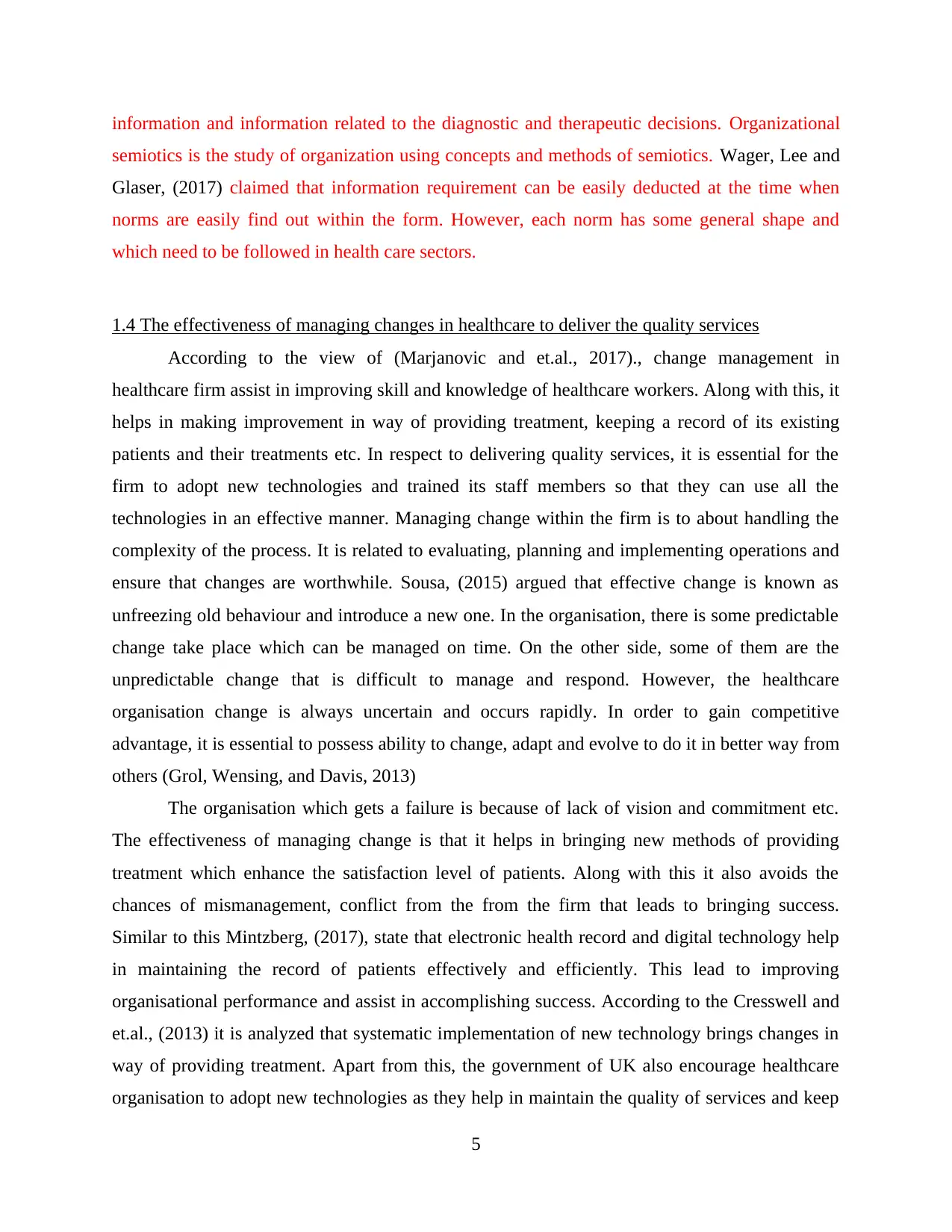
information and information related to the diagnostic and therapeutic decisions. Organizational
semiotics is the study of organization using concepts and methods of semiotics. Wager, Lee and
Glaser, (2017) claimed that information requirement can be easily deducted at the time when
norms are easily find out within the form. However, each norm has some general shape and
which need to be followed in health care sectors.
1.4 The effectiveness of managing changes in healthcare to deliver the quality services
According to the view of (Marjanovic and et.al., 2017)., change management in
healthcare firm assist in improving skill and knowledge of healthcare workers. Along with this, it
helps in making improvement in way of providing treatment, keeping a record of its existing
patients and their treatments etc. In respect to delivering quality services, it is essential for the
firm to adopt new technologies and trained its staff members so that they can use all the
technologies in an effective manner. Managing change within the firm is to about handling the
complexity of the process. It is related to evaluating, planning and implementing operations and
ensure that changes are worthwhile. Sousa, (2015) argued that effective change is known as
unfreezing old behaviour and introduce a new one. In the organisation, there is some predictable
change take place which can be managed on time. On the other side, some of them are the
unpredictable change that is difficult to manage and respond. However, the healthcare
organisation change is always uncertain and occurs rapidly. In order to gain competitive
advantage, it is essential to possess ability to change, adapt and evolve to do it in better way from
others (Grol, Wensing, and Davis, 2013)
The organisation which gets a failure is because of lack of vision and commitment etc.
The effectiveness of managing change is that it helps in bringing new methods of providing
treatment which enhance the satisfaction level of patients. Along with this it also avoids the
chances of mismanagement, conflict from the from the firm that leads to bringing success.
Similar to this Mintzberg, (2017), state that electronic health record and digital technology help
in maintaining the record of patients effectively and efficiently. This lead to improving
organisational performance and assist in accomplishing success. According to the Cresswell and
et.al., (2013) it is analyzed that systematic implementation of new technology brings changes in
way of providing treatment. Apart from this, the government of UK also encourage healthcare
organisation to adopt new technologies as they help in maintain the quality of services and keep
5
semiotics is the study of organization using concepts and methods of semiotics. Wager, Lee and
Glaser, (2017) claimed that information requirement can be easily deducted at the time when
norms are easily find out within the form. However, each norm has some general shape and
which need to be followed in health care sectors.
1.4 The effectiveness of managing changes in healthcare to deliver the quality services
According to the view of (Marjanovic and et.al., 2017)., change management in
healthcare firm assist in improving skill and knowledge of healthcare workers. Along with this, it
helps in making improvement in way of providing treatment, keeping a record of its existing
patients and their treatments etc. In respect to delivering quality services, it is essential for the
firm to adopt new technologies and trained its staff members so that they can use all the
technologies in an effective manner. Managing change within the firm is to about handling the
complexity of the process. It is related to evaluating, planning and implementing operations and
ensure that changes are worthwhile. Sousa, (2015) argued that effective change is known as
unfreezing old behaviour and introduce a new one. In the organisation, there is some predictable
change take place which can be managed on time. On the other side, some of them are the
unpredictable change that is difficult to manage and respond. However, the healthcare
organisation change is always uncertain and occurs rapidly. In order to gain competitive
advantage, it is essential to possess ability to change, adapt and evolve to do it in better way from
others (Grol, Wensing, and Davis, 2013)
The organisation which gets a failure is because of lack of vision and commitment etc.
The effectiveness of managing change is that it helps in bringing new methods of providing
treatment which enhance the satisfaction level of patients. Along with this it also avoids the
chances of mismanagement, conflict from the from the firm that leads to bringing success.
Similar to this Mintzberg, (2017), state that electronic health record and digital technology help
in maintaining the record of patients effectively and efficiently. This lead to improving
organisational performance and assist in accomplishing success. According to the Cresswell and
et.al., (2013) it is analyzed that systematic implementation of new technology brings changes in
way of providing treatment. Apart from this, the government of UK also encourage healthcare
organisation to adopt new technologies as they help in maintain the quality of services and keep
5

records of new and existing employees. Along with this healthcare firm can also use new Lewis
change management model in order to implement the changes successfully.
Organisational semiotics is the study of organisation using concepts and methods of
semiotics. It is important to understand information architecture in different context and then find
out the way it is best for representing for pervasive healthcare. However, information
architecture is related to taking the information necessity for application universal healthcare.
The existing literature for information can remain. Healthcare firm is mostly seems as
information intensive firm and a pervasive health care environment. Goal of the pervasive health
care is to render services to anyone and anywhere with the use of wireless network. Further
information architecture in it play significant role in order to provide information related to
health care. Hence it can be stated that organisational semiotic is known as one of the social
technical approach that help in sharing information in order to provide quality health care
services.
1.5 The impact of managing changes in NHS
According to the view of Imison, Castle-Clarke and Edwards, (2016), there are some
challenges and problems which can directly impact the healthcare sector after implementing
changes. It is because after implementing changes there are many employees who resist changes
and not ready to work out of their comfort zone. For example, while implementing technological
change it is not important that employees have knowledge and skills related to the use of new
technology. Therefore, healthcare firm faces difficulty and it needs to organise training and
development facility for them that consume cost and time. Hence it shows that implication of
advanced technology bring success but it increases complexity and training cost of the firm.
Similar to this Wager, Lee, and Glaser, (2017) state that to manage change is important but it is
difficult to process. However, it is not implemented properly then it leads to affect the entire
operations and activity of the firm. It is essential to formulate some strategies and planned it so
that employees can handle the changes easily and avoid resisting it. Different authors have stated
different views related to the change management in the healthcare firm.
Elton and O'Riordan, (2016) argued that managing changes in national health care
services not only positively impact but also negatively impact the firm and its operations. There
are many reasons due to which employees avoid adopting changes such they do not want to work
out of their comfort zone, or they may not have knowledge regarding the significance of changes
6
change management model in order to implement the changes successfully.
Organisational semiotics is the study of organisation using concepts and methods of
semiotics. It is important to understand information architecture in different context and then find
out the way it is best for representing for pervasive healthcare. However, information
architecture is related to taking the information necessity for application universal healthcare.
The existing literature for information can remain. Healthcare firm is mostly seems as
information intensive firm and a pervasive health care environment. Goal of the pervasive health
care is to render services to anyone and anywhere with the use of wireless network. Further
information architecture in it play significant role in order to provide information related to
health care. Hence it can be stated that organisational semiotic is known as one of the social
technical approach that help in sharing information in order to provide quality health care
services.
1.5 The impact of managing changes in NHS
According to the view of Imison, Castle-Clarke and Edwards, (2016), there are some
challenges and problems which can directly impact the healthcare sector after implementing
changes. It is because after implementing changes there are many employees who resist changes
and not ready to work out of their comfort zone. For example, while implementing technological
change it is not important that employees have knowledge and skills related to the use of new
technology. Therefore, healthcare firm faces difficulty and it needs to organise training and
development facility for them that consume cost and time. Hence it shows that implication of
advanced technology bring success but it increases complexity and training cost of the firm.
Similar to this Wager, Lee, and Glaser, (2017) state that to manage change is important but it is
difficult to process. However, it is not implemented properly then it leads to affect the entire
operations and activity of the firm. It is essential to formulate some strategies and planned it so
that employees can handle the changes easily and avoid resisting it. Different authors have stated
different views related to the change management in the healthcare firm.
Elton and O'Riordan, (2016) argued that managing changes in national health care
services not only positively impact but also negatively impact the firm and its operations. There
are many reasons due to which employees avoid adopting changes such they do not want to work
out of their comfort zone, or they may not have knowledge regarding the significance of changes
6
⊘ This is a preview!⊘
Do you want full access?
Subscribe today to unlock all pages.

Trusted by 1+ million students worldwide
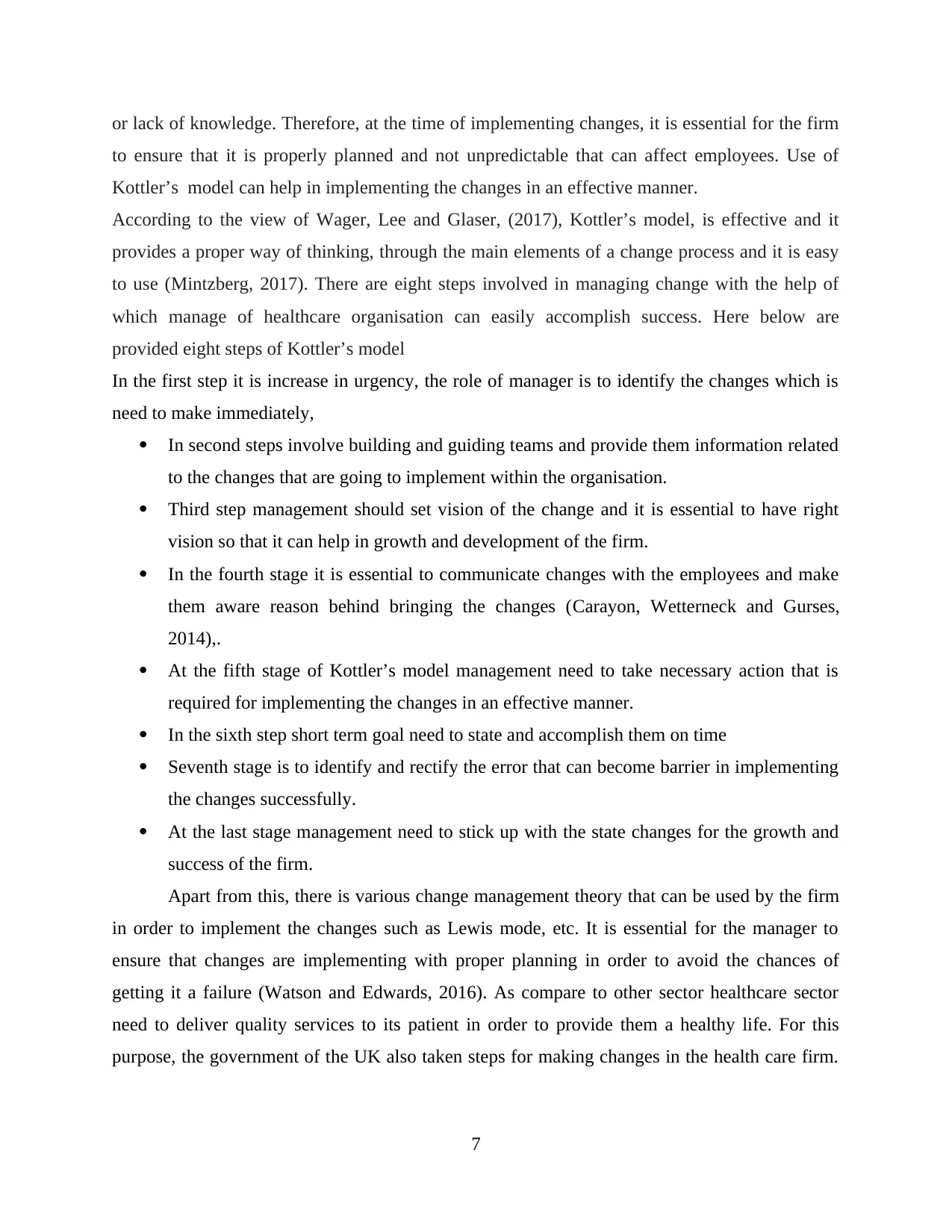
or lack of knowledge. Therefore, at the time of implementing changes, it is essential for the firm
to ensure that it is properly planned and not unpredictable that can affect employees. Use of
Kottler’s model can help in implementing the changes in an effective manner.
According to the view of Wager, Lee and Glaser, (2017), Kottler’s model, is effective and it
provides a proper way of thinking, through the main elements of a change process and it is easy
to use (Mintzberg, 2017). There are eight steps involved in managing change with the help of
which manage of healthcare organisation can easily accomplish success. Here below are
provided eight steps of Kottler’s model
In the first step it is increase in urgency, the role of manager is to identify the changes which is
need to make immediately,
In second steps involve building and guiding teams and provide them information related
to the changes that are going to implement within the organisation.
Third step management should set vision of the change and it is essential to have right
vision so that it can help in growth and development of the firm.
In the fourth stage it is essential to communicate changes with the employees and make
them aware reason behind bringing the changes (Carayon, Wetterneck and Gurses,
2014),.
At the fifth stage of Kottler’s model management need to take necessary action that is
required for implementing the changes in an effective manner.
In the sixth step short term goal need to state and accomplish them on time
Seventh stage is to identify and rectify the error that can become barrier in implementing
the changes successfully.
At the last stage management need to stick up with the state changes for the growth and
success of the firm.
Apart from this, there is various change management theory that can be used by the firm
in order to implement the changes such as Lewis mode, etc. It is essential for the manager to
ensure that changes are implementing with proper planning in order to avoid the chances of
getting it a failure (Watson and Edwards, 2016). As compare to other sector healthcare sector
need to deliver quality services to its patient in order to provide them a healthy life. For this
purpose, the government of the UK also taken steps for making changes in the health care firm.
7
to ensure that it is properly planned and not unpredictable that can affect employees. Use of
Kottler’s model can help in implementing the changes in an effective manner.
According to the view of Wager, Lee and Glaser, (2017), Kottler’s model, is effective and it
provides a proper way of thinking, through the main elements of a change process and it is easy
to use (Mintzberg, 2017). There are eight steps involved in managing change with the help of
which manage of healthcare organisation can easily accomplish success. Here below are
provided eight steps of Kottler’s model
In the first step it is increase in urgency, the role of manager is to identify the changes which is
need to make immediately,
In second steps involve building and guiding teams and provide them information related
to the changes that are going to implement within the organisation.
Third step management should set vision of the change and it is essential to have right
vision so that it can help in growth and development of the firm.
In the fourth stage it is essential to communicate changes with the employees and make
them aware reason behind bringing the changes (Carayon, Wetterneck and Gurses,
2014),.
At the fifth stage of Kottler’s model management need to take necessary action that is
required for implementing the changes in an effective manner.
In the sixth step short term goal need to state and accomplish them on time
Seventh stage is to identify and rectify the error that can become barrier in implementing
the changes successfully.
At the last stage management need to stick up with the state changes for the growth and
success of the firm.
Apart from this, there is various change management theory that can be used by the firm
in order to implement the changes such as Lewis mode, etc. It is essential for the manager to
ensure that changes are implementing with proper planning in order to avoid the chances of
getting it a failure (Watson and Edwards, 2016). As compare to other sector healthcare sector
need to deliver quality services to its patient in order to provide them a healthy life. For this
purpose, the government of the UK also taken steps for making changes in the health care firm.
7
Paraphrase This Document
Need a fresh take? Get an instant paraphrase of this document with our AI Paraphraser
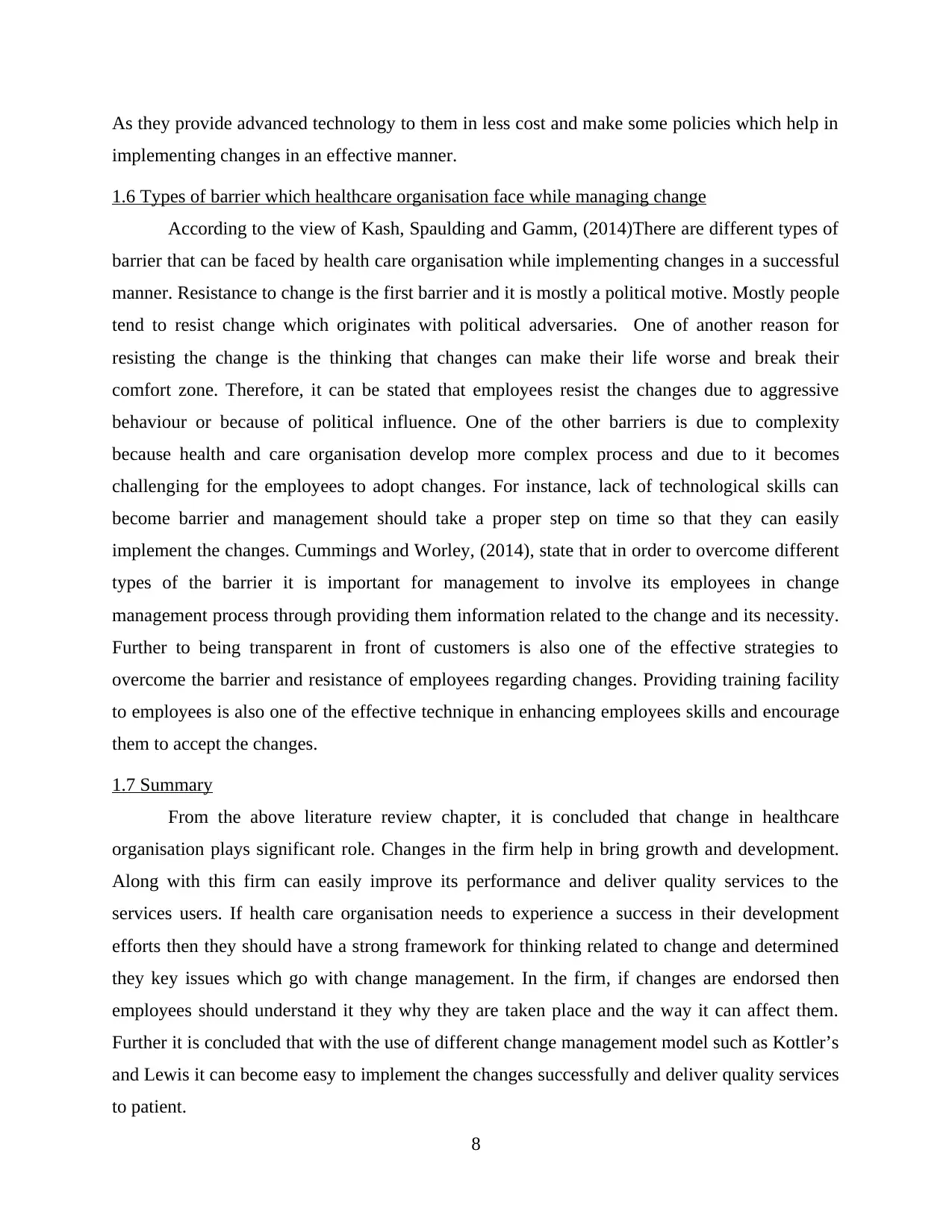
As they provide advanced technology to them in less cost and make some policies which help in
implementing changes in an effective manner.
1.6 Types of barrier which healthcare organisation face while managing change
According to the view of Kash, Spaulding and Gamm, (2014)There are different types of
barrier that can be faced by health care organisation while implementing changes in a successful
manner. Resistance to change is the first barrier and it is mostly a political motive. Mostly people
tend to resist change which originates with political adversaries. One of another reason for
resisting the change is the thinking that changes can make their life worse and break their
comfort zone. Therefore, it can be stated that employees resist the changes due to aggressive
behaviour or because of political influence. One of the other barriers is due to complexity
because health and care organisation develop more complex process and due to it becomes
challenging for the employees to adopt changes. For instance, lack of technological skills can
become barrier and management should take a proper step on time so that they can easily
implement the changes. Cummings and Worley, (2014), state that in order to overcome different
types of the barrier it is important for management to involve its employees in change
management process through providing them information related to the change and its necessity.
Further to being transparent in front of customers is also one of the effective strategies to
overcome the barrier and resistance of employees regarding changes. Providing training facility
to employees is also one of the effective technique in enhancing employees skills and encourage
them to accept the changes.
1.7 Summary
From the above literature review chapter, it is concluded that change in healthcare
organisation plays significant role. Changes in the firm help in bring growth and development.
Along with this firm can easily improve its performance and deliver quality services to the
services users. If health care organisation needs to experience a success in their development
efforts then they should have a strong framework for thinking related to change and determined
they key issues which go with change management. In the firm, if changes are endorsed then
employees should understand it they why they are taken place and the way it can affect them.
Further it is concluded that with the use of different change management model such as Kottler’s
and Lewis it can become easy to implement the changes successfully and deliver quality services
to patient.
8
implementing changes in an effective manner.
1.6 Types of barrier which healthcare organisation face while managing change
According to the view of Kash, Spaulding and Gamm, (2014)There are different types of
barrier that can be faced by health care organisation while implementing changes in a successful
manner. Resistance to change is the first barrier and it is mostly a political motive. Mostly people
tend to resist change which originates with political adversaries. One of another reason for
resisting the change is the thinking that changes can make their life worse and break their
comfort zone. Therefore, it can be stated that employees resist the changes due to aggressive
behaviour or because of political influence. One of the other barriers is due to complexity
because health and care organisation develop more complex process and due to it becomes
challenging for the employees to adopt changes. For instance, lack of technological skills can
become barrier and management should take a proper step on time so that they can easily
implement the changes. Cummings and Worley, (2014), state that in order to overcome different
types of the barrier it is important for management to involve its employees in change
management process through providing them information related to the change and its necessity.
Further to being transparent in front of customers is also one of the effective strategies to
overcome the barrier and resistance of employees regarding changes. Providing training facility
to employees is also one of the effective technique in enhancing employees skills and encourage
them to accept the changes.
1.7 Summary
From the above literature review chapter, it is concluded that change in healthcare
organisation plays significant role. Changes in the firm help in bring growth and development.
Along with this firm can easily improve its performance and deliver quality services to the
services users. If health care organisation needs to experience a success in their development
efforts then they should have a strong framework for thinking related to change and determined
they key issues which go with change management. In the firm, if changes are endorsed then
employees should understand it they why they are taken place and the way it can affect them.
Further it is concluded that with the use of different change management model such as Kottler’s
and Lewis it can become easy to implement the changes successfully and deliver quality services
to patient.
8

9
⊘ This is a preview!⊘
Do you want full access?
Subscribe today to unlock all pages.

Trusted by 1+ million students worldwide
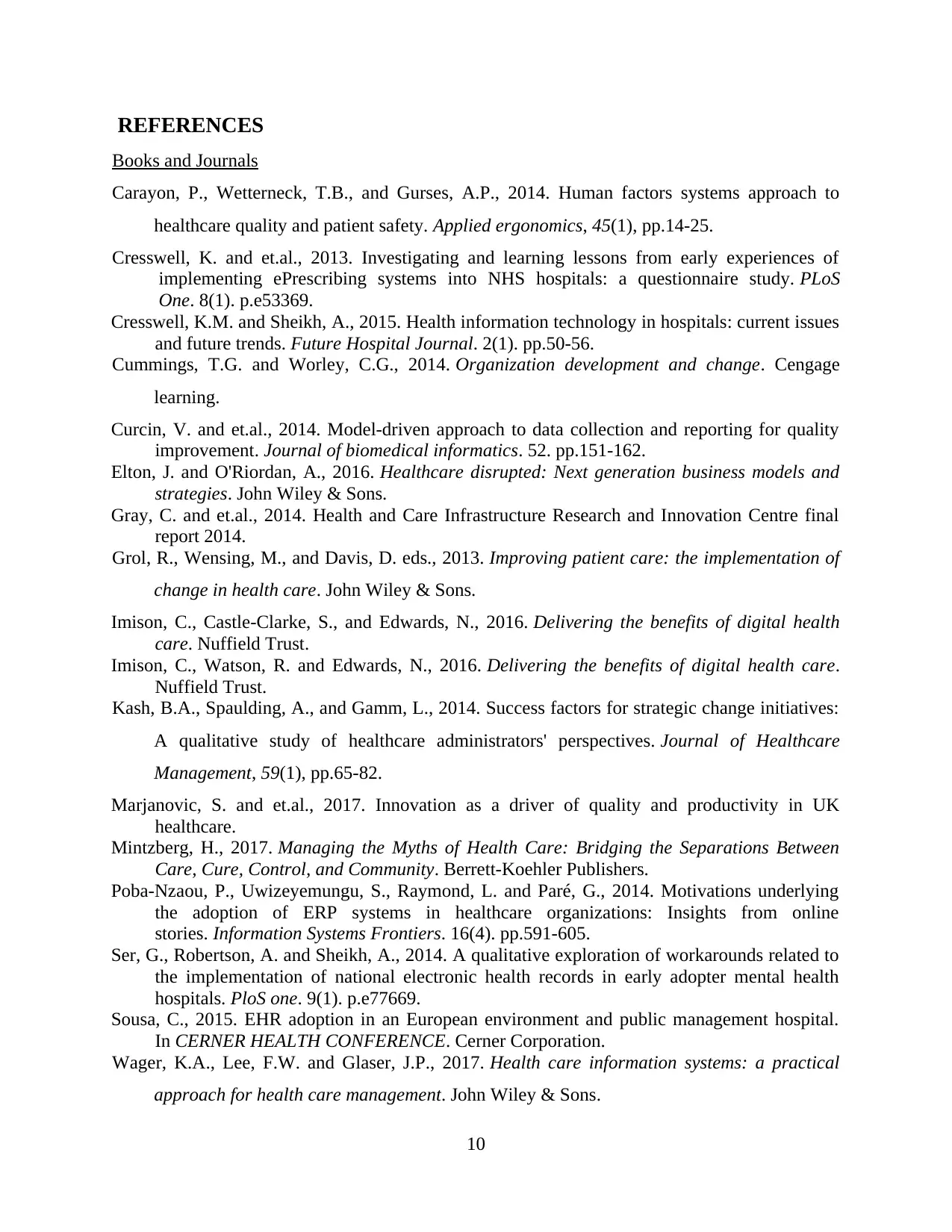
REFERENCES
Books and Journals
Carayon, P., Wetterneck, T.B., and Gurses, A.P., 2014. Human factors systems approach to
healthcare quality and patient safety. Applied ergonomics, 45(1), pp.14-25.
Cresswell, K. and et.al., 2013. Investigating and learning lessons from early experiences of
implementing ePrescribing systems into NHS hospitals: a questionnaire study. PLoS
One. 8(1). p.e53369.
Cresswell, K.M. and Sheikh, A., 2015. Health information technology in hospitals: current issues
and future trends. Future Hospital Journal. 2(1). pp.50-56.
Cummings, T.G. and Worley, C.G., 2014. Organization development and change. Cengage
learning.
Curcin, V. and et.al., 2014. Model-driven approach to data collection and reporting for quality
improvement. Journal of biomedical informatics. 52. pp.151-162.
Elton, J. and O'Riordan, A., 2016. Healthcare disrupted: Next generation business models and
strategies. John Wiley & Sons.
Gray, C. and et.al., 2014. Health and Care Infrastructure Research and Innovation Centre final
report 2014.
Grol, R., Wensing, M., and Davis, D. eds., 2013. Improving patient care: the implementation of
change in health care. John Wiley & Sons.
Imison, C., Castle-Clarke, S., and Edwards, N., 2016. Delivering the benefits of digital health
care. Nuffield Trust.
Imison, C., Watson, R. and Edwards, N., 2016. Delivering the benefits of digital health care.
Nuffield Trust.
Kash, B.A., Spaulding, A., and Gamm, L., 2014. Success factors for strategic change initiatives:
A qualitative study of healthcare administrators' perspectives. Journal of Healthcare
Management, 59(1), pp.65-82.
Marjanovic, S. and et.al., 2017. Innovation as a driver of quality and productivity in UK
healthcare.
Mintzberg, H., 2017. Managing the Myths of Health Care: Bridging the Separations Between
Care, Cure, Control, and Community. Berrett-Koehler Publishers.
Poba-Nzaou, P., Uwizeyemungu, S., Raymond, L. and Paré, G., 2014. Motivations underlying
the adoption of ERP systems in healthcare organizations: Insights from online
stories. Information Systems Frontiers. 16(4). pp.591-605.
Ser, G., Robertson, A. and Sheikh, A., 2014. A qualitative exploration of workarounds related to
the implementation of national electronic health records in early adopter mental health
hospitals. PloS one. 9(1). p.e77669.
Sousa, C., 2015. EHR adoption in an European environment and public management hospital.
In CERNER HEALTH CONFERENCE. Cerner Corporation.
Wager, K.A., Lee, F.W. and Glaser, J.P., 2017. Health care information systems: a practical
approach for health care management. John Wiley & Sons.
10
Books and Journals
Carayon, P., Wetterneck, T.B., and Gurses, A.P., 2014. Human factors systems approach to
healthcare quality and patient safety. Applied ergonomics, 45(1), pp.14-25.
Cresswell, K. and et.al., 2013. Investigating and learning lessons from early experiences of
implementing ePrescribing systems into NHS hospitals: a questionnaire study. PLoS
One. 8(1). p.e53369.
Cresswell, K.M. and Sheikh, A., 2015. Health information technology in hospitals: current issues
and future trends. Future Hospital Journal. 2(1). pp.50-56.
Cummings, T.G. and Worley, C.G., 2014. Organization development and change. Cengage
learning.
Curcin, V. and et.al., 2014. Model-driven approach to data collection and reporting for quality
improvement. Journal of biomedical informatics. 52. pp.151-162.
Elton, J. and O'Riordan, A., 2016. Healthcare disrupted: Next generation business models and
strategies. John Wiley & Sons.
Gray, C. and et.al., 2014. Health and Care Infrastructure Research and Innovation Centre final
report 2014.
Grol, R., Wensing, M., and Davis, D. eds., 2013. Improving patient care: the implementation of
change in health care. John Wiley & Sons.
Imison, C., Castle-Clarke, S., and Edwards, N., 2016. Delivering the benefits of digital health
care. Nuffield Trust.
Imison, C., Watson, R. and Edwards, N., 2016. Delivering the benefits of digital health care.
Nuffield Trust.
Kash, B.A., Spaulding, A., and Gamm, L., 2014. Success factors for strategic change initiatives:
A qualitative study of healthcare administrators' perspectives. Journal of Healthcare
Management, 59(1), pp.65-82.
Marjanovic, S. and et.al., 2017. Innovation as a driver of quality and productivity in UK
healthcare.
Mintzberg, H., 2017. Managing the Myths of Health Care: Bridging the Separations Between
Care, Cure, Control, and Community. Berrett-Koehler Publishers.
Poba-Nzaou, P., Uwizeyemungu, S., Raymond, L. and Paré, G., 2014. Motivations underlying
the adoption of ERP systems in healthcare organizations: Insights from online
stories. Information Systems Frontiers. 16(4). pp.591-605.
Ser, G., Robertson, A. and Sheikh, A., 2014. A qualitative exploration of workarounds related to
the implementation of national electronic health records in early adopter mental health
hospitals. PloS one. 9(1). p.e77669.
Sousa, C., 2015. EHR adoption in an European environment and public management hospital.
In CERNER HEALTH CONFERENCE. Cerner Corporation.
Wager, K.A., Lee, F.W. and Glaser, J.P., 2017. Health care information systems: a practical
approach for health care management. John Wiley & Sons.
10
Paraphrase This Document
Need a fresh take? Get an instant paraphrase of this document with our AI Paraphraser
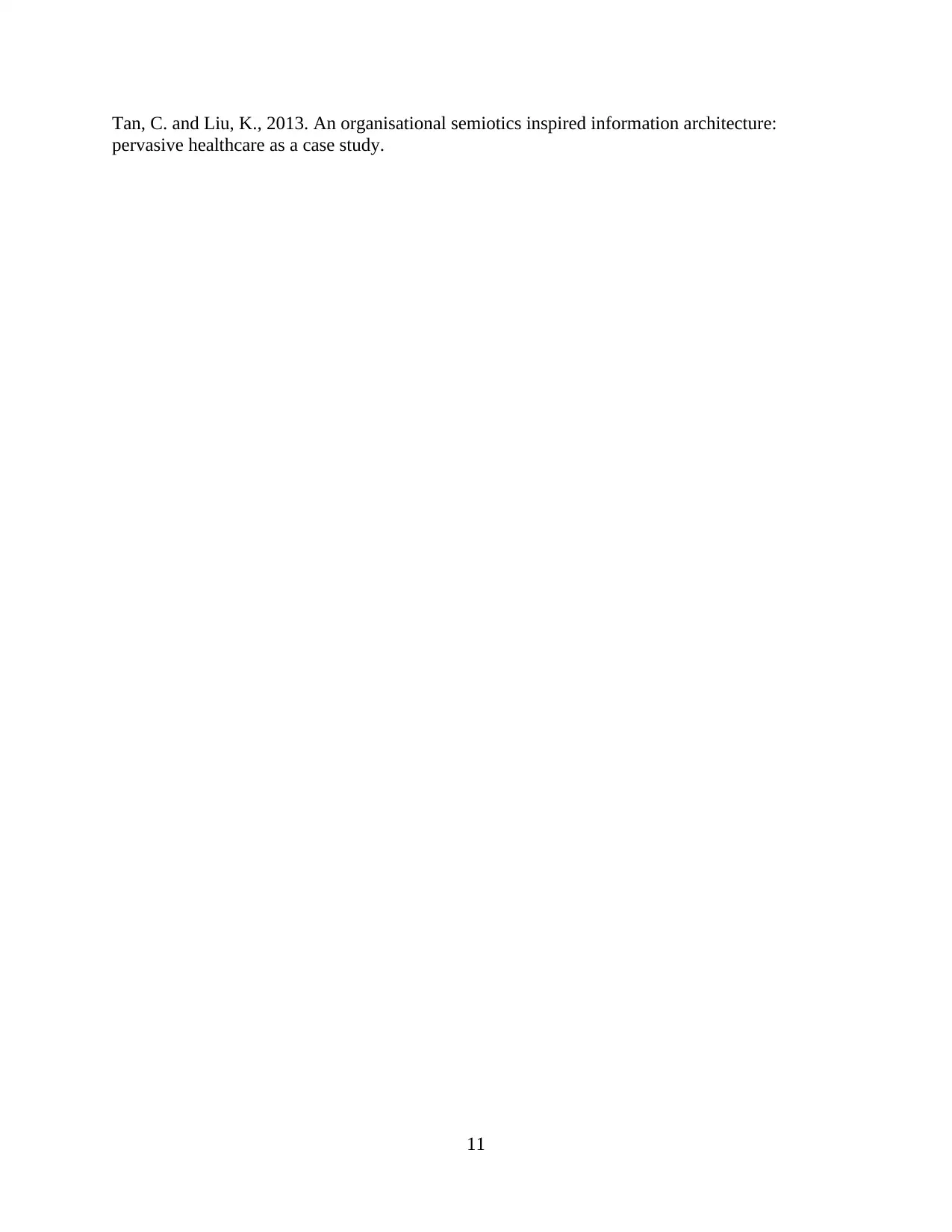
Tan, C. and Liu, K., 2013. An organisational semiotics inspired information architecture:
pervasive healthcare as a case study.
11
pervasive healthcare as a case study.
11
1 out of 11
Related Documents
Your All-in-One AI-Powered Toolkit for Academic Success.
+13062052269
info@desklib.com
Available 24*7 on WhatsApp / Email
![[object Object]](/_next/static/media/star-bottom.7253800d.svg)
Unlock your academic potential
Copyright © 2020–2025 A2Z Services. All Rights Reserved. Developed and managed by ZUCOL.





